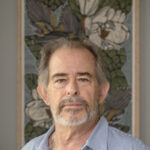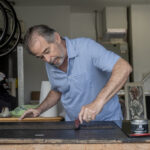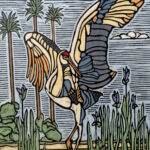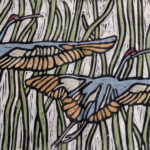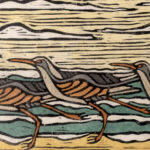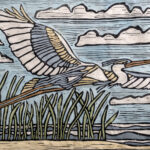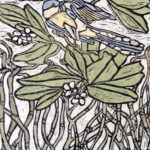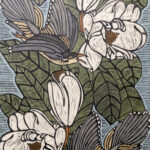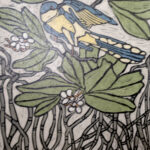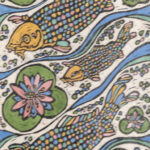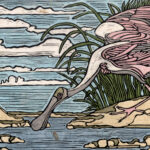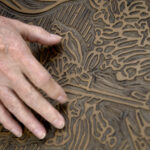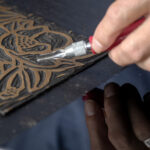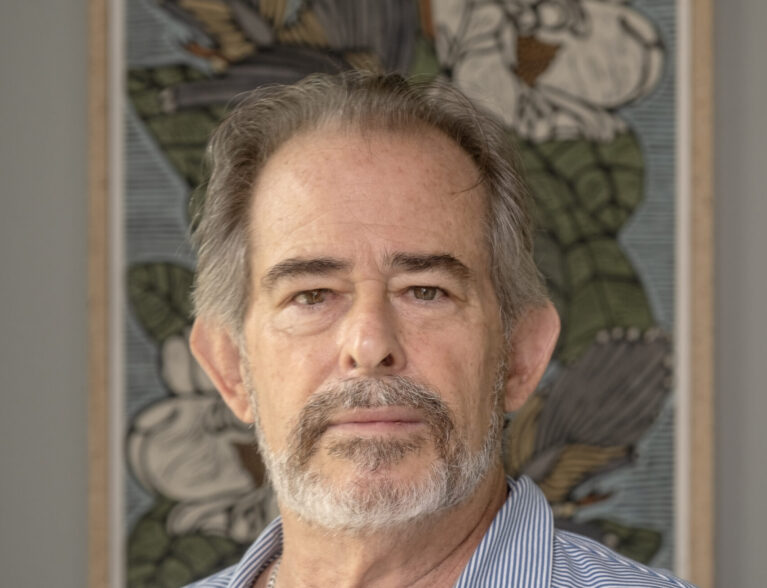
John Davis, a printmaker, graphic designer and framer, is one of those fortunate artists who has been able to make a living from his talents, using skills honed over more than four decades.
“Basically, I’m a printmaker, working with a relief print,” says Davis.
To begin the process, he draws the designs to be printed, many of which are inspired by the natural world.
Artists, he says, have an eye for certain things.
“And if you’re exposed to nature – we used to kayak quite a bit, we would travel, and I study different things – that’s when you get a lot of ideas. Right now, I’m studying birds,” he says.
“It’s actually an education when you start realizing the types of birds, their shapes, the types of plants they’re attracted to. It’s the whole concept of learning something in nature and carrying it through. I think that’s what motivates me.”
For example, one of his artworks features a wren in a horse chestnut tree, an idea inspired when visiting their son in England. Other pieces have focused on wading birds amongst the mangroves, fish, turtles and other marine life, and his current work in progress features some marsh rabbits he saw at Jaycee Park.
The drawing is then transformed graphically into lines, shapes and forms.
“If you look at my work, it’s very linear and very graphic,” he says.
Davis says he needs to be careful, though, as the designs are ultimately reverse printed; noting, for example, that birds drawn flying to the right will print as flying to the left.
The design complete, he then uses a carving tool – his favorite is a V-shaped Speedball – to carve the design into linoleum.
“When I started learning how to do this, I used to carve them out of wood, so they were known as woodcuts. Now, because I’m using linoleum, it becomes a linocut,” he explains, adding that while he liked the feel of the wood, its availability is more limited.
Whether wood or lino, he explains that the block print process involves carving away negative space (depressions), leaving the raised, positive surfaces that will be imprinted.
“The whole concept is that if you want a tiny line, you just basically cut it lighter. If you want it deeper, you take the full width of the blade. So you control how wide or how narrow your line is.”
When the carving is complete, he evenly coats a brayer (roller) with ink on a pane of glass and then rolls it onto the carved lino block. Once inked, he places paper on top, presses on it with a tool called a baren, and peels off the paper to reveal the imprint.
He currently limits his blocks to one or two colors, applying acrylic paint with a brush to other areas using colors that are unavailable in ink.
“I’m also utilizing the color of the paper as part of the design of the finished piece,” Davis says, pointing to white areas in the works.
His preferred paper is a mulberry-based composite handmade in Thailand, which he says absorbs but doesn’t bleed like some other papers do. It also does not tear easily.
Finished products are mounted onto an archival board and sealed with the same type of UV sealer used on paintings. Once dry, they are then placed into frames that he builds specifically for each piece.
Davis says he became acquainted with the art form early on in life.
“I was born and raised, the first part of my life, in Puerto Rico, and I had the fortune to be instructed at the age of about 10 or 12 by one of the well-known island artists. He was also a printmaker and was hired to create poster art and he taught me how to do it,” says Davis.
When they weren’t surfing, Davis and his brother began designing and screen-printing T-shirts for events and festivals.
“That’s really why I went into graphics.”
When his father, an architect, took a position as a professor at Tulane University, the family moved to New Orleans. Davis studied at Tulane also, earning a BFA in 1986, and after graduation, worked for four years in commercial graphics before deciding it wasn’t for him.
Davis instead utilized the framing skills learned during a part-time job in college and opened a picture framing gallery in New Orleans, and later Pensacola, to promote his work and that of others. It was then that he started doing block prints.
Davis eventually closed his “brick and mortar” business and, for the last couple of decades, has been selling at shows and festivals, garnering a wall-full of awards. He has cut back in recent years, and now does about 10 a year.
A member of the Vero Beach Art Club, Davis has had a booth at the club’s Under the Oaks Fine Arts and Crafts Show for the past four years, and his wife Jewel volunteers at the show.
“Booth 98. I’m always next to a friend of mine, Evan Schwartz,” says Davis.
“It’s a great club. I mean, there’s just an immense amount of people, and the talent’s really good. There are a lot of professional career artists who live here that are retired. The quality of the work spans so long a period of time. You sit there going, ‘Goodness gracious.’”
Photos by Joshua Kodis

